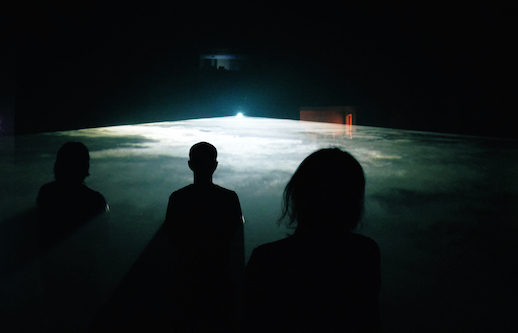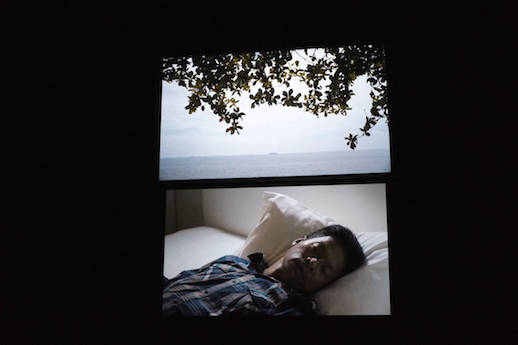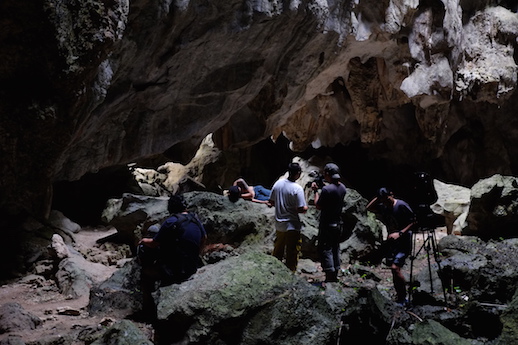Fever Room
With humidity levels sitting at a 94%, it would seem rather apt that the Tokyo premiere of Apichatpong Weerasethakul’s Fever Room would happen during rainy season, the weather itself almost emulating the director’s native Thailand.
Part of Asia in Resonance 2019 – a festival that aims to promote cross-cultural artistic exchange between ASEAN countries and Japan – Fever Room first debuted in Yokohama two years ago, but was brought to Tokyo Metropolitan Theater this year for a limited four-day run.
Already an accomplished director with major film festivals under his belt, Weerasethakul decided for this particular work to delve into the world of performance arts. The result is an innovative film/art crossover that blends feature film and installation work.

While Weerasethakul simply describes Fever Room as a film, it is clear from the outset that this is a work that cannot be so easily defined. He manages to build suspense before guests have even entered the theatre. Once admitted to the lobby area, notices inform guests that they will be admitted into the Playhouse in order of ticket number and that they will not be allowed to leave for the 90-minute duration of the performance. Latecomers will not be admitted.
After being led through a series of dimly lit corridors and into a darkened room, guests are directed to sit in on bleacher-style benches or on cushions on the floor. The Emergency Exit sign is switched off so that the room becomes pitch black, and the film commences.
Engulfed in darkness, Fever Room seems to be an exploration of the fine line that exists between dreams and reality; the foggy moment when conscious thoughts give way to those deep beneath the surface. Viewers watch as two people lie next to each other in a hospital room recounting their dreams, only to realise they are explaining the same one.
Almost Lynchian in nature, the imagery is minimalistic, and despite its simple subject matter, arguably unsettling. We are shown a town by the river; a close-up of dogs playing; trees rustling in the wind. Simple images with no context – as if the viewers themselves have been transported into someone else’s dreams or memories.
“You never really remember the beginning of a dream, do you? You always wind up right in the middle of what’s going on,” Leonardo DiCaprio mused as the lead character in Inception, the 2010 science fiction action film written and directed by Christopher Nolan. And while on the surface there are virtually no similarities between Weerasethakul’s work and Nolan’s Hollywood blockbuster, this particular line certainly rings true.

Throughout Fever Room, viewers are dropped in and out of scattered scenes from the protagonist’s dreams. As we travel further into deep sleep, an extra cinema screen floats down from the top of ceiling, along with two more at either side of the room. Fully cocooned in imagery and sound, the audience watches on as they are transported to a cave, venturing deeper down into darkness. In the cave, a man with a flashlight animates the story taking place in front of us as if to emulate primitive storytelling.
Light flickers in the darkness and then dreams become reality in Weerasethakul’s masterful finale. Throughout the performance, the audience has naturally assumed it has been staring at screen against a back wall. This has not been the case. A curtain is removed and we realise we are in fact sitting on the stage of the Tokyo Metropolitan Theatre.
The entire theatre stretches out in front of us, and at that moment dry ice is pumped into the vast cavernous room. Through the thick fog, a high-powered projector sends streams of light racing through the theatre at incredible speed, creating circular motions that transport us into a tunnel of light. The audience, which had been firmly rooted in reality and watching a dream on a screen, is now fully immersed in a dream of its own – one that is disintegrating before its eyes.

With a crushing dark ambient soundscape not dissimilar to Lustmord, and a visual climax not dissimilar to the credits of Akira, Fever Room reaches its crescendo in spectacular fashion. It leaves the viewer fully satisfied, but also wondering if the film work from the start could stand up in its own right. Probably not. But that’s okay. This was a performance piece designed to start slow and end big, with both mediums of the installation relying on each other in equal measure.
Over the last decade, Japan has been one of the leading countries to consistently support Weerasethakul’s career path as a visual artist, offering awards, major installations and funding. Let’s hope this support continues, for it is clear that this is an artist who not only wants to challenge what type of films are made today: He wants to challenge the concept of cinema itself.



